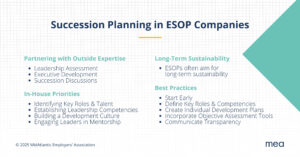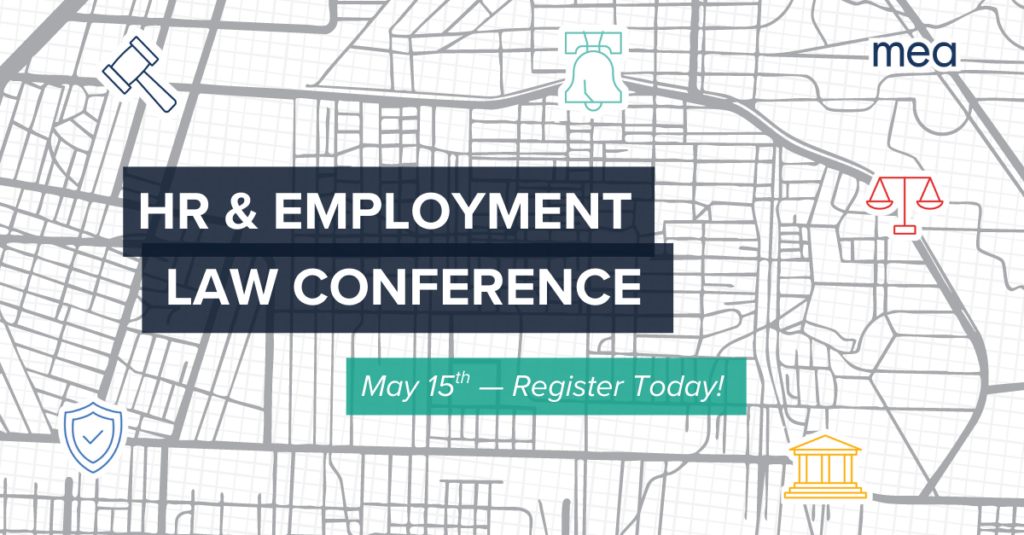For ESOP organizations, succession planning transcends traditional leadership development to encompass the preservation of ownership culture, the continuity of employee-owner engagement, and the protection of long-term enterprise value. Unlike conventionally structured companies where leadership transitions primarily affect operational continuity, ESOP leadership changes directly impact the cultural foundations that drive employee ownership behaviors and business performance.
The stakes are fundamentally higher in employee-owned companies. Leadership transitions that fail to preserve ownership culture can undermine employee engagement, erode the collaborative decision-making processes that distinguish ESOPs, and ultimately compromise the competitive advantages that employee ownership creates. For C-suite executives and boards of directors, succession planning represents a fiduciary responsibility that extends beyond operational continuity to encompass the stewardship of employee-owner investments and expectations.
The Strategic Imperative: Beyond Traditional Leadership Development
ESOP organizations face succession planning complexities that conventional companies never encounter. The interdependence between leadership effectiveness and ownership culture creates unique requirements for successor identification, development, and transition management that demand specialized approaches to talent development and organizational capability building.
Effective ESOP succession planning must address the systematic preservation of ownership mentality across leadership generations, the maintenance of collaborative governance structures during leadership transitions, and the protection of employee-owner confidence in organizational direction and financial stewardship. These requirements create development needs that extend far beyond technical competencies to encompass cultural leadership, ownership philosophy, and the sophisticated communication skills necessary to maintain employee-owner engagement.
Critical Succession Challenges in Employee-Owned Organizations
Ownership Culture Continuity and Leadership Philosophy
The most significant succession risk in ESOP organizations involves the potential discontinuity of ownership culture during leadership transitions.
Incoming leaders who lack deep understanding of employee ownership principles or commitment to collaborative decision-making can inadvertently undermine the cultural foundations that drive ESOP performance advantages.
This challenge is particularly acute when succession planning focuses primarily on technical competencies while neglecting the cultural leadership capabilities that distinguish effective ESOP leaders from conventional managers. Organizations must develop systematic approaches to identifying, assessing, and developing the ownership mindset and collaborative leadership skills that sustain employee ownership culture.
Employee-Owner Engagement and Confidence Management
Leadership transitions in ESOP companies directly impact employee-owner confidence in organizational direction and their personal ownership investment. Unlike traditional companies where leadership changes primarily affect current employees, ESOP transitions influence the perceived value and security of employee ownership stakes.
Successful succession planning must include comprehensive communication strategies that maintain employee-owner confidence, demonstrate continuity in ownership commitment, and provide transparency about leadership development processes that reinforce the organization’s dedication to employee ownership principles.
Institutional Knowledge and Relationship Preservation
ESOP organizations often depend heavily on institutional knowledge and stakeholder relationships that departing leaders have developed over extended tenures. The loss of this knowledge and these relationships can significantly impact operational effectiveness and stakeholder confidence.
Effective succession planning requires systematic knowledge transfer processes, relationship transition strategies, and documentation of critical business processes that ensure organizational capability continuity regardless of individual leadership changes.
Strategic Framework for ESOP Succession Excellence
Comprehensive Leadership Pipeline Development
Successful ESOP succession planning requires multi-level leadership development that creates advancement pathways from front-line supervision through executive leadership.
This approach ensures that ownership culture principles are embedded throughout the leadership pipeline and that succession options exist across all organizational levels.
The most effective programs integrate foundational leadership development with advanced management capabilities and executive-level coaching that specifically addresses the unique requirements of leading in employee-owned environments. These programs must address both technical competencies and the cultural leadership skills necessary to maintain ownership engagement and collaborative decision-making effectiveness.
Competency-Based Assessment and Development Planning
ESOP leadership development requires sophisticated assessment approaches that evaluate both traditional management capabilities and ownership culture leadership competencies. These assessments must identify individuals who demonstrate natural alignment with employee ownership principles while possessing the technical skills necessary for business leadership.
Development planning based on these assessments creates individualized pathways that address specific competency gaps while building the comprehensive skill sets necessary for ESOP leadership success. The most effective approaches include stretch assignments, mentorship relationships, and experiential learning opportunities that develop ownership culture leadership capabilities alongside technical expertise.
Systematic Knowledge Transfer and Transition Management
Effective succession execution requires structured approaches to knowledge transfer and stakeholder relationship transition that minimize disruption to business operations and employee-owner confidence. These processes must address both explicit knowledge documentation and the tacit knowledge transfer that occurs through mentorship and collaborative transition periods.
The most sophisticated organizations implement transition management frameworks that include stakeholder communication strategies, knowledge documentation requirements, and structured handoff processes that ensure continuity in both operational effectiveness and ownership culture maintenance.
Implementation Considerations and Organizational Capabilities
Internal Development Infrastructure
ESOP organizations must develop internal capabilities for ongoing leadership assessment, development planning, and succession readiness evaluation that exceed requirements in conventional companies.
These capabilities include competency framework development, assessment administration, and the coaching skills necessary to develop ownership culture leadership capabilities.
Effective internal infrastructure includes systematic approaches to high-potential identification, individual development plan creation and monitoring, and the feedback mechanisms necessary to ensure development effectiveness and succession readiness.
External Expertise Integration
The complexity of ESOP succession planning often requires external expertise in leadership assessment, development program design, and transition facilitation that most internal teams cannot provide cost-effectively. External partners bring objectivity in succession candidate evaluation, specialized knowledge of ESOP leadership requirements, and proven methodologies for leadership development program design.
Specialized consulting support becomes particularly valuable for organizations implementing comprehensive succession planning frameworks, developing advanced leadership programs, or navigating significant leadership transitions that require sophisticated change management and stakeholder communication approaches.
The most effective external partnerships provide flexible program design that adapts to organizational needs, proven development methodologies that address ESOP-specific leadership requirements, and ongoing support that ensure sustained development effectiveness and succession readiness.
Measuring Succession Planning Effectiveness
Successful succession planning requires systematic measurement approaches that evaluate both development program effectiveness and succession readiness across the leadership pipeline. Key performance indicators should include leadership bench strength assessments, development program completion and effectiveness metrics, and employee-owner confidence in leadership continuity.
The most sophisticated organizations implement annual succession readiness assessments that evaluate both immediate succession capabilities and long-term leadership pipeline strength, enabling proactive adjustments to development strategies and succession planning approaches.
Conclusion: Succession Planning as Competitive Advantage
For ESOP organizations, succession planning represents far more than risk mitigation, it constitutes a strategic capability that enables sustained competitive advantage through continuous leadership effectiveness and ownership culture preservation. The systematic development of leadership pipelines that embody employee ownership principles create organizational resilience that conventional companies cannot replicate.
Organizations that invest in comprehensive succession planning capabilities position themselves to maintain the ownership culture advantages that drive superior performance while ensuring the leadership continuity necessary for long-term employee-owner value creation. The development of these capabilities requires specialized expertise, sustained commitment, and systematic approaches that address the unique complexities of leading in employee-owned environments.
The ESOP structure provides the foundation for employee ownership, but effective succession planning ensures that leadership capability and ownership culture evolve together to create sustained organizational excellence that benefits all employee-owners over the long term.





